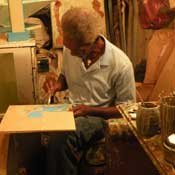Charles Smith's favorite story is one of revelation: "Cutting grass one day, I had this urge to look up at the pear tree. I saw white blooms. Two weeks later ... the white blooms had turned into small pears, and I had the most shocking revelation. The tree was born to bloom. The pear came out of the bloom ... the bloom came ... out of the tree. It changed the course of my thinking," Smith said.
"All life comes from inside of something. Milk comes out of cows. Eggs come out of a chicken. Babies come out of a woman. If I want to produce something that's alive, it's got to come from inside of me."
Reclining in a plush chair in the living room of his home in Brandon, Smith, 70, makes another revelation: the fledgling artist was 9 when he started making and selling blackberry wine.
"I would sell it to the kids," Smith says. "I would sell 'em a cup of wine for a nickel. Or some cookies. If they had some cookies, I'd give 'em a cup of wine."
Smith came to his art in his 40s, after what he describes as "a basic life: good, moral living." When he was 5, his mother and father split up and left him and his four siblings with his grandparents. Smith's grandparents were sharecroppers, and he lived with 10 other relatives in their three-bedroom house with no electricity or running water.
Smith helped his grandparents on the farm, growing vegetables and raising cows, chickens, and hogs.
"It was just a good life," he says. "When I wasn't working, I'd be ... in the woods. The woods were what I thrived on."
Even today, Smith seeks respite in the woods. "I get a bottle of white Zinfandel and some cheese, and I hit the woods," he says, laughing.
The landscape surrounding Smith's house and studio conjures a southern variation on a Pissarro pastoral, with expansive open fields, honeysuckle and the occasional gravel road. Smith's work, like his life, seems entrenched in this pastoral theme.
Some of his most popular pieces are simulated mountable birds' nests, and his watercolors, boasting bright colors and loose organic forms, invoke the bliss of his childhood. His media, too, reflects the natural; Smith mostly paints on wood canvases and sculpts in wood.
In high school, Smith played basketball and had leading roles in several school plays, but he quit school and left home at 15.
"Chasing them girls," Smith says, chuckling.
In 1958, Smith beat up a white man in Jackson. "Back in those days that was a no-no," Smith says.
"(The white men) come to kill me, and I got shot, but I got away. I went to Jackson, caught the train and went to Chicago."
Smith says his time in Madison, Wis., was the most instrumental in developing his artist's identity. During his time there, from 1963 to 1981, Smith worked as a playwright and credits Madison's "intellectual environment" with altering his thinking.
"It opened me up to another side of life, made me more of a pioneer; let my attitude have some heat in it, some life," he says.
When he was 36, Smith moved from Wisconsin to Pearl to be with a woman he was dating and, at 39, he met his future wife, Mabel. The couple has been married for 27 years. Smith worked as a landscaper for 15 years, but took up painting to design a cover for his book, "The Gift of Understanding."
The impulse to paint proved insatiable. For three and a half years, Smith sold his work at the Mississippi Farmers Market. It was there that Smith met Jason Callander, who invited Smith to display his artwork at the Mississippi State University School of Architecture downtown.
Of the exhibit's title, "Double Take: The Two Sides of Charles E. Smith," he says, "There are two sides to all of us. There's a negative and a positive."
Smith's studio is a cramped space connected to his garage. His unconventional work area coexists with an unconventional artistic process.
"I take a whole bucket of paint and put it on the board and start shaping it," he says. "I can't ... do an outline. I need to be free to explore where I want to go."
He adds: "I don't want to do anything that someone else has done. I want it (my art) to be hot and fresh."
Smith has a daughter, Jessica, 26, and a son, Peter, 25, who leaves for Iraq in July for eight months. "Have you seen the painting I did for my son?" Smith asks, more than a few times.
We move to a bedroom to see the painting--tree-like forms splashed on a narrow panel.
"I'm in my field now," Smith says, "Art--that's where I'm supposed to be."
"Double Take" hangs at the MSU School of Architecture (509 E. Capitol St.) until the end of July. View by appointment only; call 601-969-6448. You can also view pieces online at tinyurl.com/5tmr8bo.


